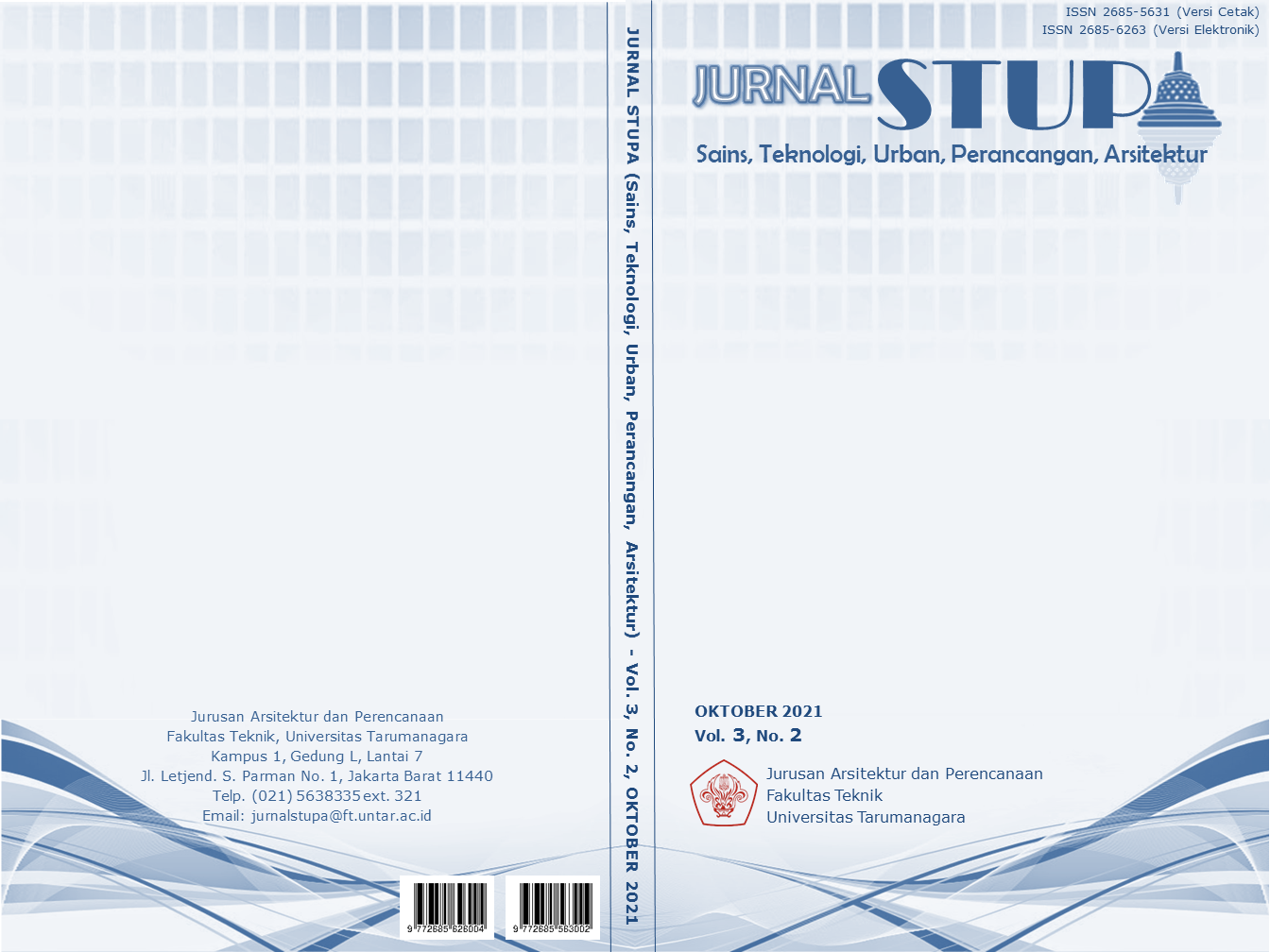GRIYA MODE BERKELANJUTAN DI KOTA BEKASI
Main Article Content
Abstract
The increasing consumption of clothing every year gives birth to a new concept, namely fast fashion. It is a modern term for cheap and trendy clothes that take fashion ideas from fashion shows or fashionable styles from celebrities. The fast fashion work system is known as a mass process that is able to produce clothes quickly. However, this process uses too many natural resources and is detrimental to the environment. Even though the results of the fabric produced are not comparable to the nature that was sacrificed. The concept of fast fashion which should be able to harmonize production and consumers will lose balance. This project has a goal to build an architectural masterpiece that can reduce the negative impact of the fashion industry on environmental pollution. Inviting the public to participate in changing a consumptive and hedonistic culture. Thus creating a community that is aware of a better lifestyle to become a productive and circular generation in fashion consumption. In its design, Atelier Bow-Wow's Behaviorology Strategy method is used which studies the context of environmental, social and economic concerns that seek to turn problems into opportunities as a basic aspect of eco-friendly design. This study also uses the Nonidentity-programming method by Bernard Tschumi to create programs in circular architectural works, and parametric methods in planning the design of the building's facade. It is hoped that this project will be able to deal with the environmental crisis caused by the practice of the fashion industry in order to create a sustainable life.
Keywords: sustainable, fashion, lifestyle, environment
Abstrak
Meningkatnya konsumsi pakaian setiap tahunnya melahirkan konsep baru yaitu fast fashion. Ini adalah sebuah istilah modern untuk pakaian murah dan trendi yang mengambil ide mode dari peragaan busana atau gaya modis dari selebriti. Sistem kerja fast fashion dikenal sebagai proses masal yang mampu menghasilkan pakaian dengan cepat. Akan tetapi, proses ini menggunakan sumber daya alam yang terlalu banyak dan merugikan lingkungan. Padahal hasil kain yang dihasilkan tidak sebanding dengan alam yang dikorbankan. Konsep fast fashion yang harusnya mampu menyelaraskan produksi dan konsumennya akan kehilangan keseimbangan. Proyek ini memiliki tujuan untuk membangun sebuah karya arsitektur yang mampu mengurangi dampak negatif industri fesyen terhadap pencemaran lingkungan. Mengajak masyarakat untuk berpartisipasi dalam mengubah budaya yang konsumtif dan hedonisme. Sehingga menciptakan sebuah komunitas yang sadar akan gaya hidup yang lebih baik untuk menjadi generasi yang produktif dan sirkular dalam konsumsi fesyen. Dalam perancangannya digunakan metode Behaviorology Strategy milik Atelier Bow-Wow yang mempelajari konteks kepedulian terhadap lingkungan, sosial dan ekonomi yang berusaha mengubah masalah menjadi peluang sebagai aspek dasar dalam desain yang ramah akan ekologi. Studi ini juga menggunakan metode Nonidentity- programming oleh Bernard Tschumi untuk menciptakan program dalam karya arsitektur yang sirkular, dan metode parametrik dalam perencanaan desain bangunan fasadnya. Diharapkan proyek ini mampu dalam menghadapi persoalan krisis lingkungan akibat praktek industri fesyen demi menciptakan kehidupan yang berkesinambungan.
Article Details
References
Aktas, A. P. (2012). Sustainable Design Proposals in Shopping Center Public Interior. International Journal of Energy and Environtment.
Gissen, D. (2003). Big and Green: Toward Sustainable Architecture in the 21st Century. New York: Princeton Architectural Press .
Levy, M. dan Weitz, B.A., (2008). Retailing Management. 7th ed., Boston: McGraw-Hill/Irwin
Sutanto, A, (2021). Dromos-oikos. Kuliah Stupa 8.31. Prodi Arsitektur Universitas Tarumanagara.
Sutanto, A, (2020). Peta Metode Desain. Prodi Arsitektur Universitas Tarumanagara.
Egerton, F. (2013). EgertonHistory of Ecological Sciences, Part 47: Ernst Haeckel's Ecology.
https://esajournals.onlinelibrary.wiley.com/doi/full/10.1890/0012-9623-94.3.222
Fairus, S. (2018). Kajian Fast Fashion dalam Percepatan Budaya Konsumerisme https://journals.telkomuniversity.ac.id/rupa/article/view/1329
Jerobisonif, A. (2019). Konsep dan Metode Desain Arsitektur Bernard Tschumi https://ejurnal.undana.ac.id/gewang/article/view/1644
Pratama, M. (2020). Menjamurnya Industri Fast Fashion di Negara Berkembang Meskipun Menimbulkan Berbagai Dampak Negatif https://www.researchgate.net/publication/342513032_Menjamurnya_Industri_Fast_Fashion_di_N egara_Berkembang_Meskipun_Menimbulkan_Berbagai_Dampak_Negatif
Stanford Encyclopedia of Philosophy.2005 https://plato.stanford.edu/entries/ecology/
Tahalele, Y. (2015). Analisa Produk Fesyen Berkelanjutan, Berfield https://webcache.googleusercontent.com/search?q=cache:LLB1tZ00ZoQJ:https://www.uc.ac.id/en visi/wp-content/uploads/publikasifpd/ENVISIFPD-2020
Undang-Undang No. 3 Tahun 2014 tentang Perindustrian Tekstil https://www.google.com/url?sa=t&rct=j&q=&esrc=s&source=web&cd=&cad=rja&uact=8&ved= 2ahUKEwi80tiC6cTxAhXFWisKHXj2AU8QFnoECBUQAA&url
Wardana, A. (2014). Definisi Ekologi Arsitektur. arsitek.html.https://alvinwardana.wordpress.com/2014/05/11/definisi-ekologi/arsitektur


